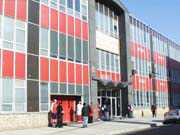More than three quarters, or 271, of New Jersey’s 361 high schools have received a warning that if they don’t improve in the next year, they risk being put on the state’s list of failing schools.
In Hudson County, 16 high schools made the “early warning” list, including Hoboken High School. Hoboken High School, in fact, fared worse than many of the schools in the state, ranking higher than only 16 of them.
On the other hand, there is good news: the city’s two middle schools passed the federal requirements, while well more than half of the middle schools in the county failed. In all, 29 middle schools in Hudson County were put on the “early warning” list.
State educators, including Education Commissioner William Librera, have criticized the federal program that created the standards as flawed and unrealistic.
Assessment of the schools is based on the High School Proficiency Test (HSPT) in the high school and the Grade Eight Proficiency Assessment test in the middle schools. It also evaluates 40 different factors. Should a school miss the mark on one indicator for two consecutive years, it is deemed “in need of improvement.”
The 40 indicators include a 95 percent participation rate in language arts literacy and math tests, as well as meeting the Adequate Yearly Progress (AYP) benchmark target in the same subject areas. Data is then examined by looking at 10 subgroups, or types of students.
The list that was released Oct. 1 was part of President George W. Bush’s No Child Left Behind initiative, which has the goal of improving the quality of education by holding schools to higher and more identifiable standards. According to federal legislation, schools placed on an “in need of improvement” list may face sanctions and be required to offer parents the option of transferring their children to another school.
Many educators and most Democrats in the legislature have gone on the record saying that the standards are too harsh, and demand an unrealistic time table for schools to show improvements. Critics have also said that many of the schools on the list are in reality exemplary, but were skewed by the grades of special education students or those with limited proficiency in English.
A few indicators
Out of 271 high schools in the state identified as “Early Warning” schools, 85 of them got the designation as a result of missing only one or two indicators (about one-third, or 31 percent). Also, 149 schools out of 271 missed the mark in less than four indicators out of 40.
“These are not ‘failing’ schools,” said Librera. “Many of these fine schools have been placed in ‘early warning’ because they did not meet criteria for one or two indicators out of 40. That does not equate to ‘failing’ – not in the least. Any characterization that these schools are ‘failing’ is inaccurate and wrong.”
Hoboken Board of Education member David Anthony pointed to McNair High School in Jersey City as an example has how the system is flawed. Year in and year out, McNair, an academic magnet school, is rated by most educators as one of the state’s best schools. But according to the No Child Left Behind “report card,” it failed.
“You would have to think if the best, or one of the best, schools in the state didn’t pass, there is something wrong with the system,” said Anthony. “The particular barometer that they are using seems to me to be flawed.”
High school still testing poorly
But while politicians and superintendents across the state complain about the accounting system, the numbers released raise concerns when it comes to Hoboken High School’s test scores. Hoboken only passed 26 of the 40 criteria. Only 16 schools in the state missed more indicators than that.
Wednesday, Board of Education member Carmelo Garcia said that the school board and school administrators take the data seriously, and that steps will be taken to help remedy the test score deficiencies in the high school. “We know and understand that there are some deficiencies,” said Garcia. “This school board is going to be proactive and progressive and will develop a corrective plan.”
But with that said, Garcia added that the success in the city’s two middle schools should not be overlooked. He pointed to the fact that in the past few years enrollment has increased in the kindergarten and elementary school program, bucking a three-decade trend of declining enrollment.
Garcia complained that the federal program expects wholesale improvements and changes in test scores in a single year, even though the current crop of 11th graders have been in public school system for the past 12 years.
School board member John Raslowsky II said that he too believes that there are critical flaws in the accounting of the No Child Left Behind legislation. “It’s absurd that you have schools that by any other measure are successful, but are put on this list because they only miss one or two indicators,” said Raslowsky.
But Raslowsky added that it would be foolish not to glean some knowledge from the data, especially when it comes to the high school.
